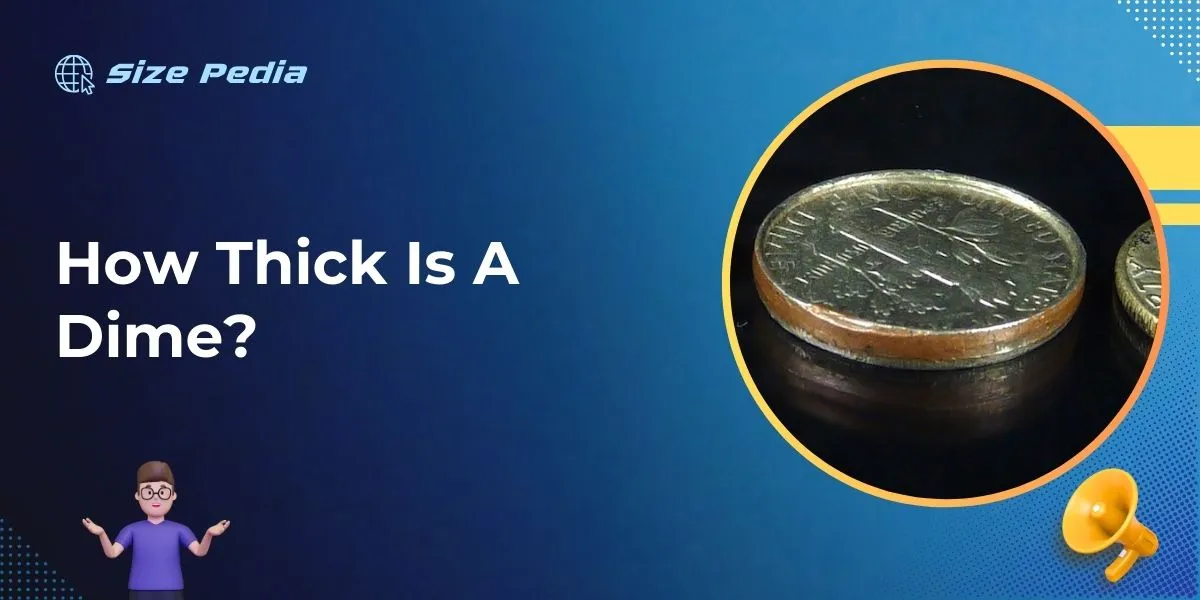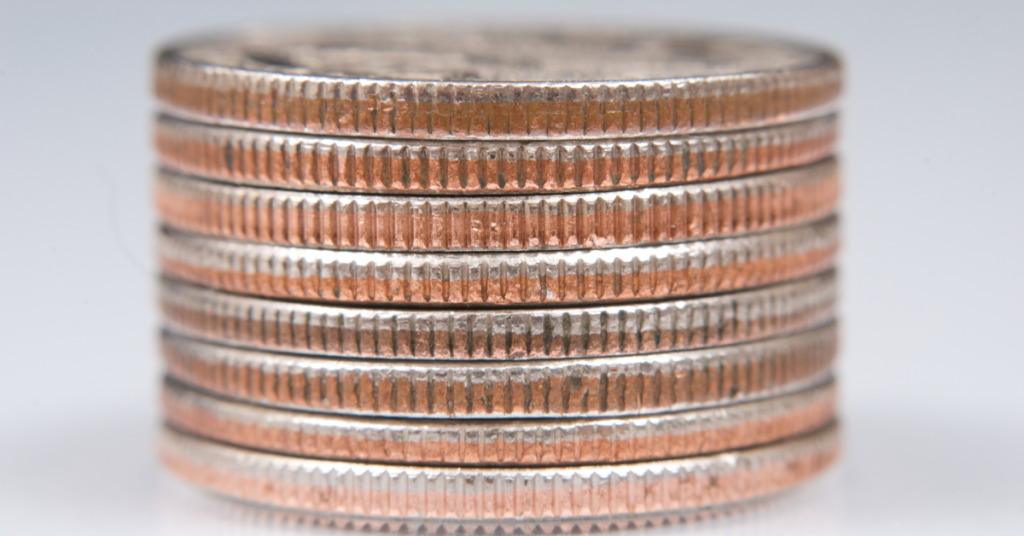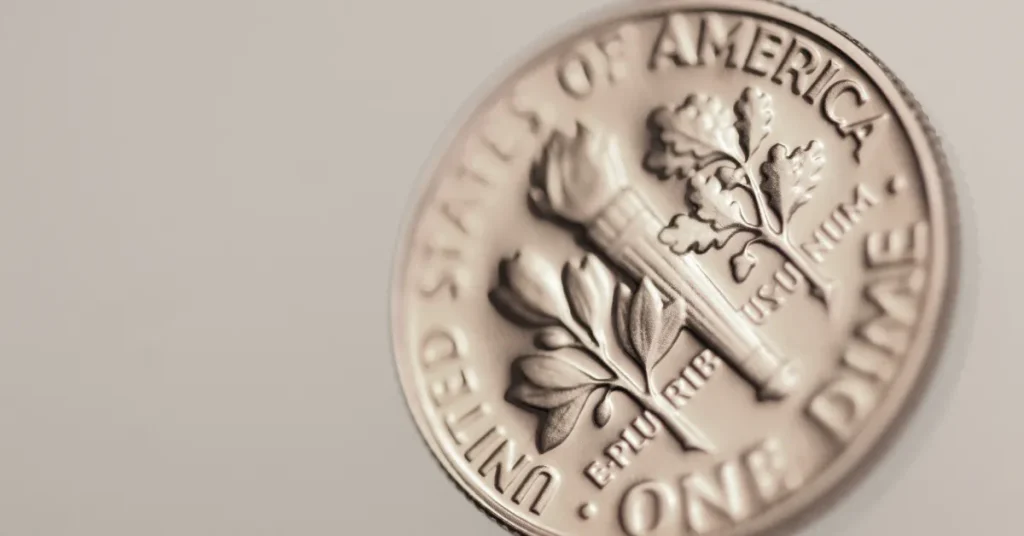A dime has a thickness of approximately 1.35mm. The United States dime, often referred to as a ten-cent piece, is the thinnest coin in circulation.
Having a firm grasp of the dimensions of currency is helpful for various reasons, ranging from numismatic interests to engineering applications.
Coins, such as the dime, are often used for comparisons due to their standard size and widespread recognition. The dime, part of US currency since 1796, has undergone several design changes, but its thickness remains a constant metric.
This 10-cent coin, which features Franklin D. Roosevelt on its obverse, plays a significant role both in everyday transactions and in teaching measurements.
Understanding the dime’s thickness is also beneficial for designing coin compartments in wallets, vending machines, and other devices that accept coins.
This silver-hued coin is not only valuable in monetary terms but also serves as a handy reference point for small-scale measurements.

The Dime’s Profile: Size Matters
When we talk about dimes, we often think of their value. Yet, their size tells a story too. Small but mighty, the dime is an essential piece of American currency. Let’s delve into the specifics of how thick a dime really is and how it stacks up against other coins.
Coin Dimensions
The U.S. Mint takes great care in creating currency. Each dime measures precisely. Its size is crucial for vending machines and coin mechanisms to work right. Here’s what you need to know about a dime’s dimensions:
- Diameter: 17.91mm
- Thickness: 1.35mm
- Weight: 2.268 grams
The dime’s thin profile makes it distinctive. Its small dimensions make it easy to handle and store.
Comparing Thickness With Other Coins
A dime’s thickness might be hard to judge on its own. So, let’s compare it to other coins to get a better picture:
| Coin | Thickness |
| Penny | 1.52mm |
| Nickel | 1.95mm |
| Quarter | 1.75mm |
| Dime | 1.35mm |
As seen in the table, the dime is the thinnest among common U.S. coins. Being thinner than a penny, nickel, and quarter makes the dime unique.
Manufacturing Process: Precision In Minting
The manufacturing process of a dime is a marvel of precision and engineering. Ensuring the exact dimensions for every single coin is no small feat.
The U.S. Mint employs intricate methods to create coins that not only hold monetary value but are also works of art. Let’s delve into how dimes achieve their specific thickness through meticulous minting processes.
Materials Used
The dime, known for its diminutive size and shiny appearance, starts its life as a blend of metals.
Primarily composed of copper and nickel, this combination yields durability and that signature silvery color. These metals are sourced and mixed with care to produce sheets called coinage strips.
Thickness Control
During minting, controlling the thickness of each dime is crucial. The U.S. Mint uses state-of-the-art technology to ensure this. Here is how the process unfolds:
- Rolling: Metal strips are rolled to a precise thickness.
- Stamping: Blanks are cut from the strips with exactness.
- Inspection: Coins are checked to meet strict tolerances.
After the dimes are stamped, they go through a rigorous quality control process. The finished product is a dime that measures just about 1.35 millimeters in thickness.
This consistency is key to ensure dimes work in vending machines and other coin-operated devices. Intricate engraving machines add the final touches, impressing designs with precision every time.
Historical Changes In Dime Thickness

Coins tell a story, not just through their engravings but through their dimensions too. The United States dime has seen its thickness change over time.
This piece of history is minted into every dime’s edge. Let’s delve into these historical changes and learn more about the dime’s evolution.
Evolution Through The Years
When dimes first entered pockets in 1796, they came with different specs. The thickness of dimes has varied as the years rolled by.
| Period | Thickness (inches) | Compelling Events |
| 1796 – 1837 | 0.053 | Early U.S. coinage begins. |
| 1837 – 1964 | 0.035 | Silver content standard. |
| 1965 – Present | 0.053 | Copper-nickel clad introduced. |
Reasons Behind The Variations
- Material Changes: Dimes shifted from pure silver to a copper-nickel blend.
- Cost Considerations: Economic factors influenced dime composition.
- Technological Advancements: Minting techniques improved over the years.
Each shift in dime thickness tells us about advancements and economic decisions made in America’s history. Collectors and enthusiasts look to these details as part of the rich narrative of U.S. coinage.
Why Dime Thickness Is Important
Dime thickness plays a crucial role in everyday transactions. At just 1.35 millimeters thick, a dime is not only the smallest but also the thinnest coin in U.S. currency. This specific dimension is vital for numerous aspects of coin design and usage.
Implications For Coin Handling
Coin handling is a part of daily life. Dime thickness affects how easily dimes are picked up, sorted, and counted. An optimal thickness ensures that dimes do not stick together, improving the accuracy of transactions.
- Enhances tactile differentiation between coins
- Makes stacking and rolling coins efficient
- Reduces jamming in mechanisms like coin wrappers
Impact On Vending Machines And Counters
Vending machines and coin counters rely on consistent coin dimensions. The thickness of a dime is key to proper identification and sorting in these machines. Even slight variations can cause malfunctions or acceptance errors.
| Feature | Impact |
| Coin Recognition | Ensures dimes are recognized correctly by machines |
| Sorting Accuracy | Aids in precise sorting, reducing errors and rejects |
| Jamming Frequency | Minimizes jams due to consistent coin dimensions |
Measuring Techniques: Ensuring Accuracy
Understanding how thick a dime is requires precise measuring techniques to ensure accuracy. When dealing with such small dimensions, every millimeter matters, and the right approach can make all the difference.
Let’s delve into the tools and standards necessary to measure a dime’s thickness effectively.
Tools For Precise Measurements
To measure a dime accurately, specific tools are essential:
- Digital Calipers: Offer precise readings and can measure down to thousandths of an inch.
- Micrometer: Another precision instrument, providing even more accuracy than calipers.
- Benchtop Measuring Microscope: Used for highly detailed inspection, it can measure small objects with high precision.
These tools ensure measurements are both reliable and repeatable.
Standards In Coin Calibration
Ensuring the accuracy of coin measurements includes adhering to standards:
| Organization | Standard |
| United States Mint | Specifies the exact dimensions coins should have |
| NIST | Provides guidelines for measurement tools calibration |
| ISO | Sets international standards for manufacturing and calibration |
All measurement tools must undergo regular calibration against these standards. This ensures that a dime’s reported thickness is as exact as the U.S. Mint intended.
The Role Of Thickness In Coin Collecting

The allure of collecting coins often lies in the details, nuances that may seem minor to the untrained eye. Among these fascinating details is the thickness of a coin, an attribute that may not leap out initially.
Within the coin collecting world, the thickness of a dime plays a subtle, yet pivotal role. Collectors and numismatists alike scrutinize this aspect, as it links deeply to a coin’s history, authenticity, and overall grade.
Thickness In Grading Coins
Coin grading is a meticulous process. Here, experts assess coins based on several criteria. Thickness is one critical benchmark. A precise thickness, consistent with mint specifications, can confirm a coin’s minting era and authenticity.
Grading services use calibrated tools to measure thickness accurate to the millimeter, ensuring no detail is missed.
- Uniformity: Thickness must match official standards.
- Wear and Tear: Thinner measurements can indicate excessive use.
- Minting Quality: Variances can signal mint errors.
Anomalies And Collector Interest
When a dime deviates from its standard thickness, collector interest often spikes. These anomalies create buzz, placing such coins in the spotlight.
Unusual thickness can result from minting errors or external factors altering the coin post-production. Collectors treasure these peculiarities, as they can greatly increase a coin’s rarity and value.
| Thickness Anomaly | Possible Cause | Collector Interest Level |
| Too Thick | Overstriking, Multiple Strikes | High |
| Too Thin | Wear, Abrasion, Metal Fatigue | Medium |
| Inconsistent | Flawed Planchet Preparation | High |
Every anomaly has a tale, and collectors are keen to decipher what those stories tell. Be it a fluke in the minting process or a rare error caught after the fact, these unique dimensions add a layer of intrigue to the inherently fascinating pursuit of coin collecting.
FAQs About How Thick Is A Dime
How Thick Is A Dime In Inches?
A dime has a thickness of 0. 053 inches.
Is A Dime Thicker Than A Penny?
No, a dime is not thicker than a penny. A penny measures 1. 52 mm in thickness while a dime is thinner at 1. 35 mm.
What Is The Thickness Of A Dime In English?
A U. S. dime has a thickness of 1. 35 millimeters.
How Thick Are Coins?
Coin thickness varies by denomination. U. S. quarters measure 1. 75 mm, dimes are 1. 35 mm, nickels at 1. 95 mm, and pennies are 1. 52 mm thick.
Conclusion
Understanding the thickness of a dime is more than trivial knowledge. It aids collectors and curious minds alike.
At 1. 35mm, dimes are surprisingly thin, yet their role in transactions is substantial. Remember, this small coin packs much history and value in its slender profile.
Keep appreciating these nuances in everyday items!
Resources:
1. https://www.usmint.gov/coins/coin-medal-programs/circulating-coins/dime
